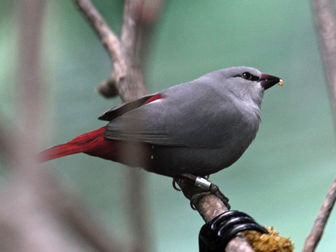Lavender waxbill
It is found in subtropical/ tropical dry shrubland habitats in Benin, Burkina Faso, Cameroon, Central African Republic, Chad, Côte d'Ivoire, Gambia, Ghana, Guinea, Guinea-Bissau, Liberia, Mali, Niger, Nigeria, Senegal, Sudan, Togo & USA . The status of the species is evaluated as Least Concern.

Original source: Own work
Author: DickDaniels (http://carolinabirds.org/)
Permission: GNU Free Documentation License
The Lavender waxbill is classified as Least Concern. Does not qualify for a more at risk category. Widespread and abundant taxa are included in this category.
The Lavender Waxbill (Estrilda caerulescens) is a common species of estrildid finch native to Central Africa and widely introduced in the USA. It has an estimated global extent of occurrence of 620,000 km². Habitat - It is found in subtropical/ tropical (lowland) dry shrubland habitats in Benin, Burkina Faso, Cameroon, Central African Republic, Chad, Côte d'Ivoire, Gambia, Ghana, Guinea, Guinea-Bissau, Liberia, Mali, Niger, Nigeria, Senegal, Sudan, Togo & USA (breeding). More
Lavender Waxbill: Feeds mostly on the small seeds of fine grasses. Also eats spiders and small insects. Readily Eats Seeds Vocalization Lavender Waxbill: Song is a quiet "see-see-see-swree" and call is a metallic "chip". Similar Species Not likely to be confused with any other species in its range. . More
Lavender Waxbill: First recorded on the Island of Oahu in 1965. They are now found on Hawaii and Maui. Prefers dry scrub habitat, lawns, parks, and gardens. Native to tropical West Africa. Voice Text "see-see-see-swree", "chip" Interesting Facts * A group of finches has many collective nouns, including a "charm", "company", and "trembling" of finches. More
perreini) is similar to the Lavender Waxbill, but is considered its own species. Origin - Africa Area of distribution - Tropical west Africa from Senegal to southwest Chad and northern Cameroon. Distribution Disposition - Lively, charming, active, inquisitive. May become aggressive while breeding, especially towards members of the same species. More
Lavender Waxbill is of the genius Extrilda. The Extrilda are considered the "True Waxbills" (see below), and are found widespread on the African continent. More
Lavender waxbills inhabit scrubby grassland and like to stay in the shorter grass along forest-edges, creeks and dense scrubby areas. They can also be spotted between rocks , in Mali they can be found in areas with Pteleopsis habeensis and Acacia macrostachya (DUHART & DESCAMPS 1963). Even in the wild Lavender-Waxbills aren’t shy birds and can be found pretty close to humans inhabiting orchards, plantations or roadside vegetation. In Nigeria they like wetlands with Raphia, but also forested areas and scrubland at the base of the isle-mountains. More
whatever other challenges Lavender Waxbills throw at you after using this site at least you will know that you have pairs determing gender of Lavender-Waxbills is not difficult experts say it's easy from their calls - they are right What's the problem then? seems we are good at describing colour & smells to each other but poor at describing complex sounds in writing a very good breeder of Lavender Waxbills describes the cock-call as a 'psee-psee' listen More

Original source: David Blank
Author: David Blank
Permission: Some rights reserved
Family : Estrildidae
Genus : Estrilda
Species : caerulescens
Authority : (Vieillot, 1817)

